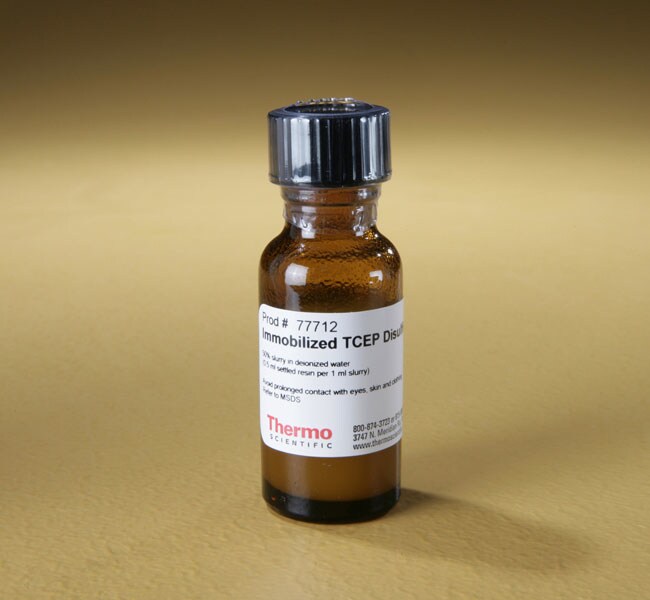
Immobilized TCEP Disulfide Reducing Gel eliminates the need to use laborious and inefficient gel filtration methods to separate the reduced sample from the reducing agent. Immobilized TCEP Disulfide Reducing Gel may be adapted conveniently to a variety of scales and formats (i.e. batch, spin column and gravity-flow column procedures). This reducing gel is for single-use applications; it cannot be regenerated and reused.
Features of Immobilized TCEP Disulfide Reducing Gel:
• Odorless—reduce proteins at your bench; contributes to a healthier lab environment
• Stable—virtually no loss of activity when stored refrigerated
• Versatile—reduces peptides and proteins over a broad range of pH, salt or detergent concentrations, and temperature conditions
• Flexible—resin slurry provides flexibility for use in spin tube, column or batch modes
• Time-saving—no soluble reductant removal saves time and conserves sample
• Efficient—cleaves both natural disulfide bonds and those incorporated by crosslinking
Advantages over soluble disulfide reducing agents:
• Excellent recovery free from reducing agent—Removing the reducing agent and recovering the reduced molecule without sample loss is a problem inherent to DTT or β-mercaptoethanol (BME). Immobilized TCEP allows you to recover reduced protein/peptide in high yield (85% or higher) without the need to dialyze or desalt.
• Odorless—Unlike DTT or BME, Immobilized TCEP is odor-free, so reductions can be carried out conveniently on the bench top.
• Stable in air—The inherent stability of TCEP eliminates any need for special precautions to avoid oxidation when handling, using or storing Immobilized TCEP Disulfide Reducing Gel.
• Easy to handle—Immobilized TCEP reductant, allows you to easily dispense the amount of support required for each application. Reductions can be conducted over a broad range of pH values (pH 4 to 9) and temperatures (5 to 95°C).
Trialkylphosphines serve as excellent agents for the reduction of disulfide bonds in proteins, peptides and other disulfide bond-containing molecules[1,2] and are relatively unreactive toward other functional groups.[3] The trialkylphosphine TCEP is stable in aqueous solutions and does not undergo the rapid oxidation that often occurs with other reducing agents such as dithiotreitol (DTT) and β-mercaptoethanol (BME).[4] TCEP does not interfere with common sulfhydryl-reactive reagents (e.g., maleimide crosslinkers).[5] Nevertheless, many protocols require recovery of the reduced sample separate from the reducing agent. Immobilized TCEP Disulfide Reducing Gel enables sample reduction and immediate recovery of reduced sample free of reducing agent.
Considerations for use of Immobilized TCEP Disulfide Reducing Gel:
• Reduction occurs over a wide range of pH (pH 4.0-9.0) and temperature (5°-95°C).
• Most proteins are reduced efficiently without a denaturant. However, adding a denaturant such as guanidine·HCl may aid in exposing internal disulfides to the Immobilized TCEP.
• Urea is not recommended as a denaturant as it forms cyanates that react with sulfhydryl groups.
• Do not allow metals to contact the Immobilized TCEP as this will decrease its activity.
• Including 5—20 mM EDTA in the sample buffer during reduction helps prevent reoxidation of the sulfhydryl groups by divalent metals such as Zn 2+, Cu 2+ and Mg 2+.
• The reduced sample should be used immediately after reduction because disulfides will reform over time.
Related Products
Pierce™ TCEP-HCl
| Code | Description |
|---|---|
| 77712 | Catalog Number: 77712 |

